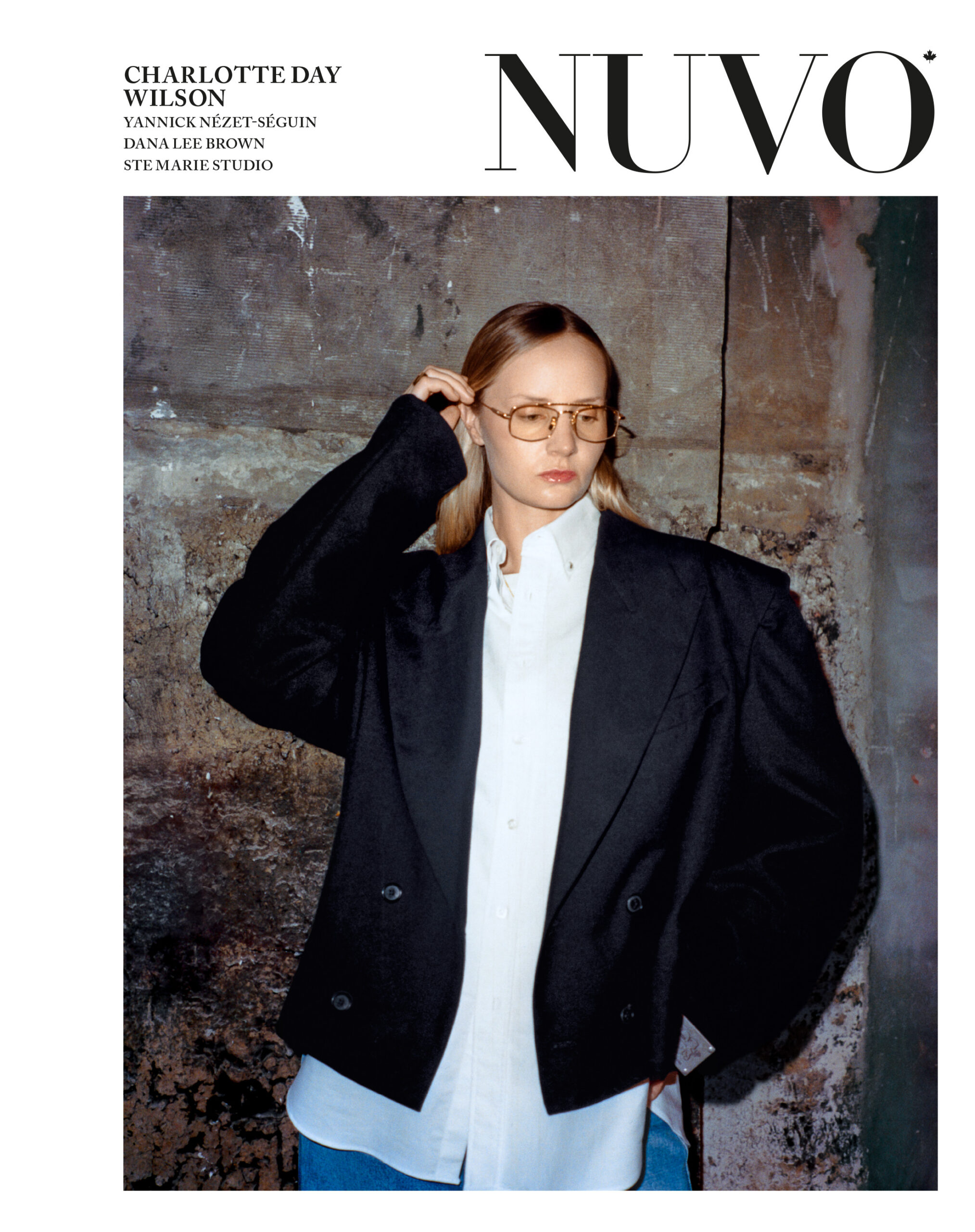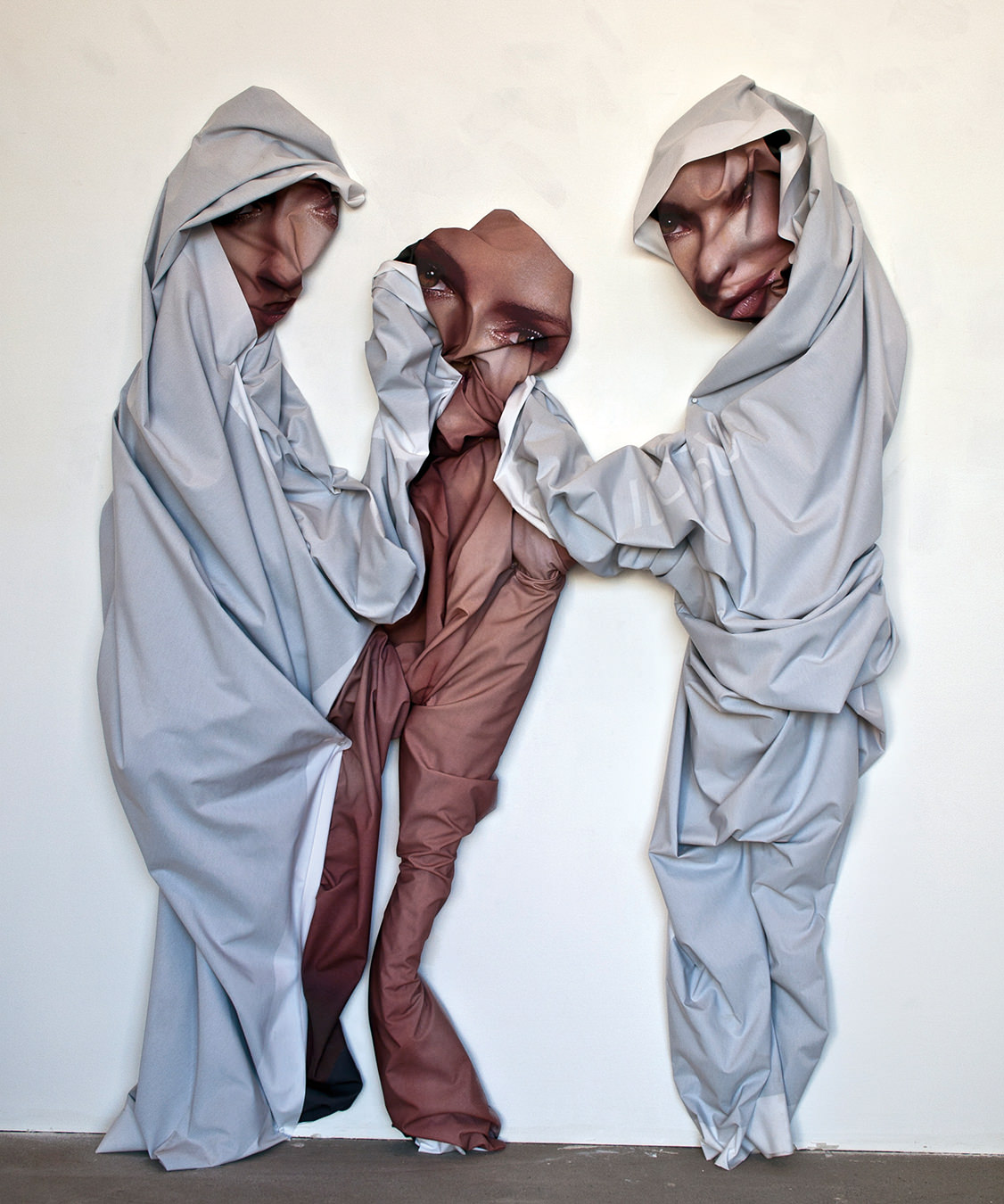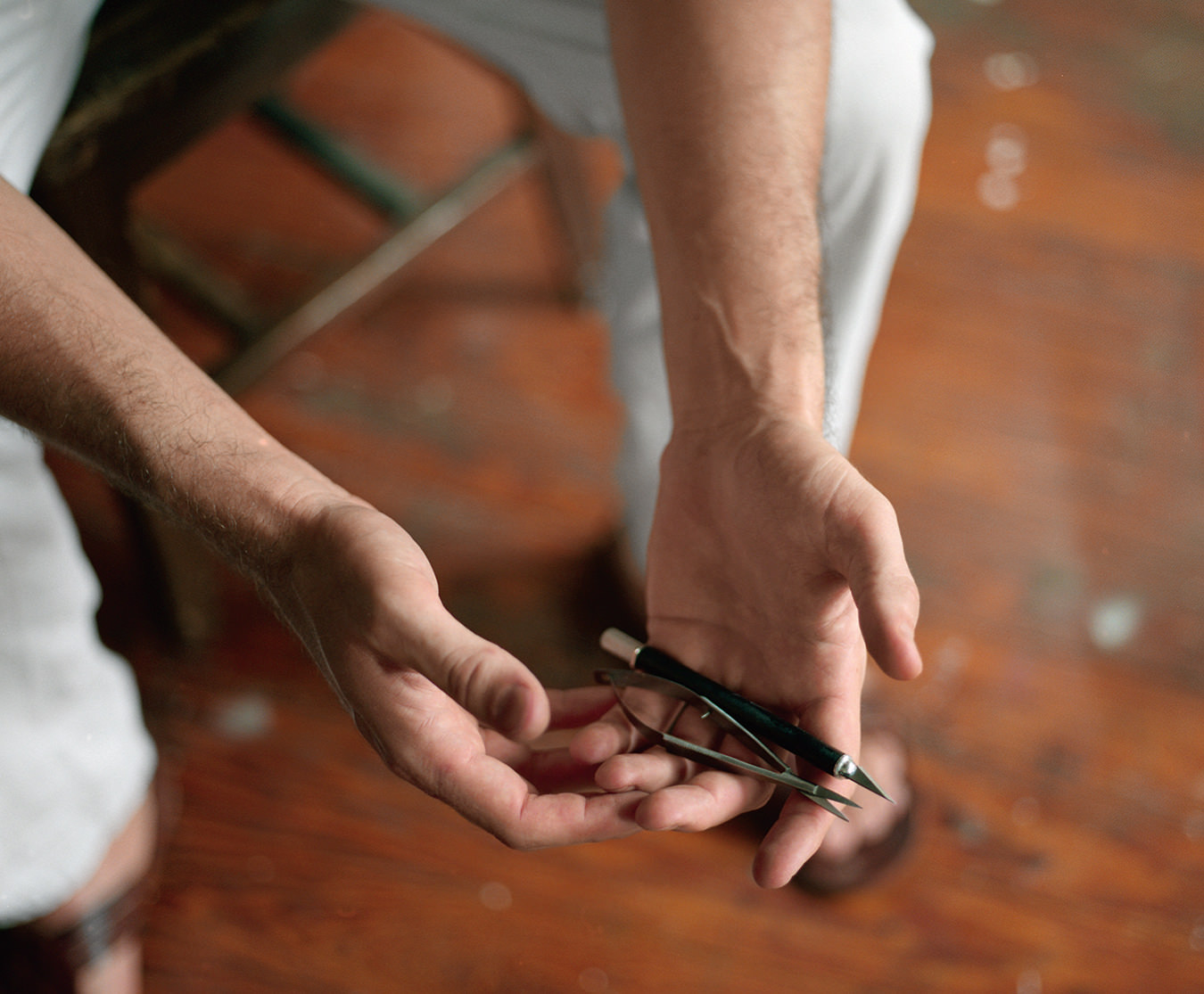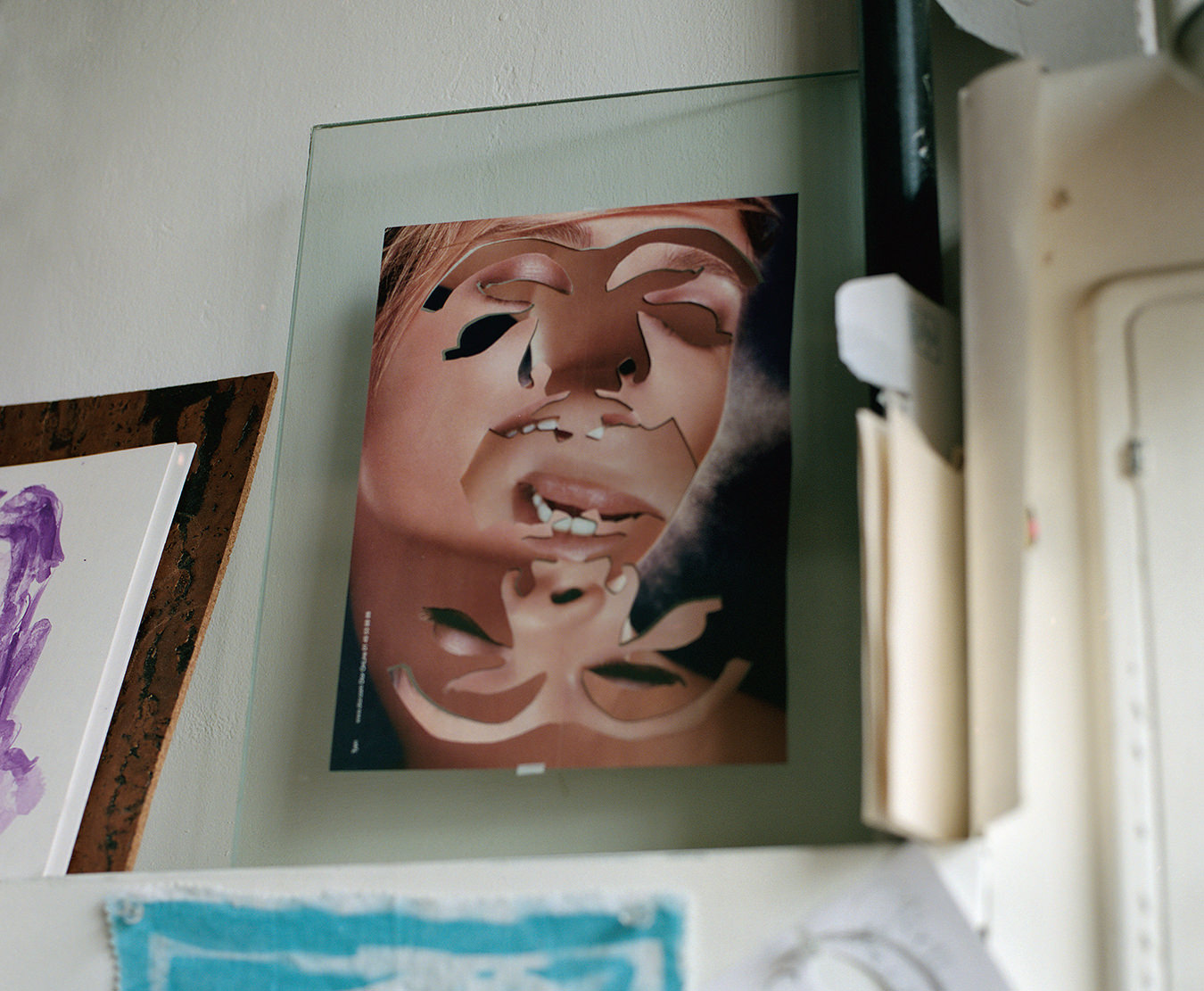It’s a scorching, humid New York summer day, but Julien Gardair, clad in khaki shorts and a long-sleeved T-shirt, is unfazed by the heat. To be polite, he flicks on the air conditioning. French people don’t use much A/C, explains the Versailles-born contemporary artist, pouring glasses of sparkling water thick with crushed limes.
It’s Sunday afternoon, and Gardair is hanging out in his Brooklyn studio, nestled in the most Italian section of Williamsburg. The versatile artist has been in New York for three years, and shares the loft with his photographer roommate, a fellow French expat. In true New York custom, both guys live and work in the industrial space, which is located near an authentic pasta factory. (“During the recession, they gave me stuff for free. It was nice,” he says.) On the kitchen wall resides their third roommate, an oversized, cartoonish bonhomme made from a piece of black tape. After two years, the tape is starting to wilt slightly.
Gardair’s studio is small and neat, packed with remnants of art and life, shelves jammed with paint cans and walls lined with paintings. Stacks of portfolios and magazines are piled here and there; fashion magazines are one of Gardair’s materials of choice. Into their pages he cuts beautifully intricate graphic designs and patterns that are actually reversible, so when the magazine image is flipped, it becomes something else entirely.
Like many creative types, Gardair actually likes working within restrictions, subscribing to the point of view that sometimes walls can be liberating because within them you can find a new sort of freedom. “I work with very big constraints,” says the 34-year-old. “I put myself into strict boundaries. To put myself in this weird state of mind where you’re really focused on the boundary, so you can get free of something, and another thing opens and you don’t even know.”
Working at home is no big deal for Gardair; he clearly possesses the self-discipline required for a fruitful freelance life. Besides, with such varied media—including not only paint, canvas, and magazines, but stamp prints, video, linoleum, carpet, cork, felt, acrylic, printed fabric, and tape—he’s often out in the field creating site-specific, immersive installations.
New York in particular has welcomed his installation work into chic public spaces like restaurants and boutiques. His Jungle Fever installation at Jérôme Dreyfuss in SoHo—which ran until the end of August—was made from a single 18-metre piece of extended bicolour felt. “I keep the integrity of the fabric,” says Gardair, who also has a decorative panel mural permanently on display at Manhattan’s Veritas restaurant, and at the Shelborne Hotel in South Beach, Miami (both projects are collaborations with Crème design and Jun Aizaki). Gardair’s also working on a new video piece with the American painter Brooke David for New York’s Big Screen Plaza.
A consistent thread connects Gardair’s work: the artist’s desire to grow, challenge himself and, by doing so, steer himself, bit by bit, toward that ever-elusive notion of freedom.
Despite so much variety—from cartoon figure outlines made from ultra-long stretches of black tape to giant linoleum cut-outs suspended in doorways—a consistent thread connects Gardair’s work: the artist’s desire to grow, challenge himself and, by doing so, steer himself, bit by bit, toward that ever-elusive notion of freedom.
“Freedom is one of the things I’m trying to catch,” he says. “I’m a very control guy. I have a really deep knowledge of art history—I saw so many things all over Europe, so I can’t pretend to come from nothing, from nowhere, but I can still try to work and get free of the thing I know, and change my habits all the time. In fact, you never know if you’re really inventing anything, but trying always to try to start from scratch.”
This concept came to life during Gardair’s recent residency at the picturesque Eden Rock resort in St. Barths last May. As artist in residence, for one-and-a-half months Gardair and his playful, textured, often abstract work infiltrated the resort. Rather than just create paintings, the artist decided to get out of the gallery and use the entire property as his living canvas, transforming the deck, buildings, even the sea into live, locale-specific installations that gently brought guests into the experience, subtly toying with their perceptions of reality. In a piece called Camera Locus—part of the “24/EDEN” solo show at the Eden Rock Gallery—Gardair projected a video installation, only visible by night, onto the building itself, and he festooned the resort with whimsical creative pieces. One was a floating sculpture called C’est pas l’homme, made of cut-up gym mats that sat on the ocean like a magical decal. Part of Gardair’s concept for the Eden Rock project on St. Barths was the decision to restrict himself to using only materials sourced from the resort and its guests. “I worked from scratch,” he says. “I came with nothing. No plans, nothing.”
Gardair’s method surprised some of the Eden Rock staff, he recalls, mischievous blue eyes flashing. He recounts a panicked e-mail received by one of the managers from another employee. “The e-mail was saying, ‘I don’t know what happened! There’s, like, grass and things all over the deck.’ On Monday morning, [the manager] told me, ‘You just have to tell me these things because people were freaking out!’ ”
Gardair was raised in France by his mother, a homemaker, and his father, a director of human resources, and Gardair is the eldest of five siblings. By the time he was 11 years old, the family had moved four times, before settling in the south of France between Montpellier and Sète, 15 kilometres from the sea. He moved to Paris to study at the École Nationale Supérieure d’Arts de Cergy-Pontoise (a 30-minute train ride from the City of Lights). He lived there for 12 years, working as an artist and showing in various galleries and spaces throughout France.
In 2007, Gardair moved to New York. “There’s no other place like it,” he says of his new home base. “You can meet so many interesting people coming from all over the world with the desire to make things, and you can see as much as 40 new shows a week. By seeing all these different works, you’re always visually challenged. That brings me all kinds of ideas.”
Video installations are among these new ideas. This fall, Gardair is developing a series of anticipated video installations, also titled Camera Locus, in Europe. These immersive installations are follow-ups to the very popular Camera Locus 2, La chevelure, which showed at Brooklyn art space Invisible Dog.
“I use a single video projector, both as the light source and image source,” explains Gardair about the Camera Locus series. “By lighting the space from a specific point, the space starts to say things through projected shadows of the architecture. This is where I start. Then I redraw every plan on the computer, step by step—something like a perspective view of the space. It works almost like a reversed camera obscura—I’m almost using the space as a canvas. And I can play with any kind of material, from drawn animations to videos. But what I like most is its lightness—you just have to switch off the projector and everything disappears into memory. At Invisible Dog, people were spending time in there playing with the shadows and dancing around. You’re part of it.”
From the viewer’s perspective, being “part of it” is a major allure of Gardair’s site-specific installation work. “I’m always trying to learn,” he says about his willingness to experiment. “When I work on a project and I feel like, ugh, this is something I knew already. I just—I don’t like that. I’m not here to deliver the thing I knew already—I’m always looking for something new.”
A recent theme in his art is a social one. Creating installations in public environments is by definition a social experience.
Camera Locus 4 will debut this September at the Homesession gallery in Barcelona. As for Camera Locus 5, it’s part of a big group show being displayed in two French national galleries: Galerie des Gobelins in Paris, and Galerie Nationale de la Tapisserie in Beauvais (Gardair’s installation will show in Beauvais). The prestigious commission evolved from a carpet he had previously designed for the French Mobilier National, which is on view in progress at the Manufacture de la Savonnerie in Lodève, France. (He got that gig through famous French artist Pierre Buraglio, who spotted Gardair’s work at a gallery at which they both showed.)
A recent theme in his art is a social one. He explains that although it’s not literally visible in the work itself, nor is it part of some covert agenda, creating installations in public environments is by definition a social experience. You can’t work in a cave to make this kind of stuff, you have to engage with people.
“There’s a social-political part that you can’t really see in the work,” he says excitedly. “All this year, I work on projects involving different people. This is something I just discovered this year, because before I was working by myself. I need other people skills.”
So last year, to make the monumental Greenouille, the largest cut-out installation of them all, Gardair recruited two assistants to help him climb precarious scaffolding and hang the massive piece 10 metres high. “It’s one roll of carpet, cut in and extended all over the space,” he says of the piece, which showed at La Graineterie art centre in the city of Houilles (also close to Paris).
And, of course, at Eden Rock, this Frenchman had to infiltrate the community. “I had to be part of all the different layers of the staff,” he says. “The first thing I had to do was meet people to see what kind of materials I could gather. I was working day and night because there was a part to see during the day and a part to see at night. After two weeks, when we finally opened the show, I got this post-opening depression or something—but then I started to meet more people there and it started to be more interesting. They asked me to stay more and I said okay!”
Gardair says he’s been learning to allow the work to lead him, instead of the other way around. “I try to not plan anything in my work. That’s something I started maybe 10 years ago. Before, I was writing ideas all the time, and then try to give a form to these ideas. Now, I try not to avoid that, but not to put this advance of the work.”
So how does a self-described “very control guy” stop controlling creation and let the creation drive him? He doesn’t have the answer, but feels one’s practice and life are intertwined. “I think I learn a lot [to] be able to improvise and just trust my hand, trust myself, and not to think in advance, through painting,” he says. “There are many ways to use painting, of course. But if you use painting with no expectations and try to just find things and follow the brush, and to see what you can learn from this—not having like a goal or a specific picture in mind—you find things you didn’t expect. That’s how, I think, I start to think this way.”











